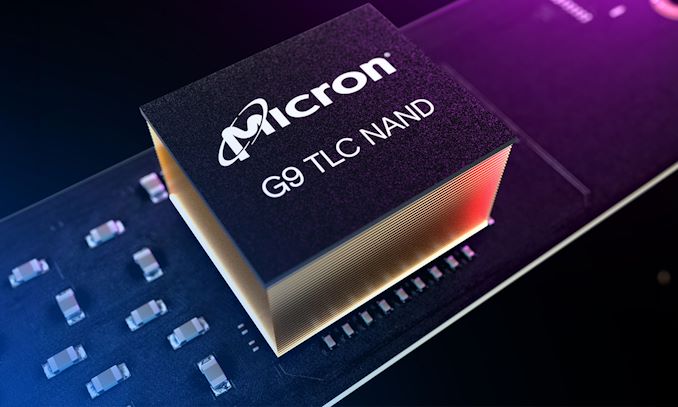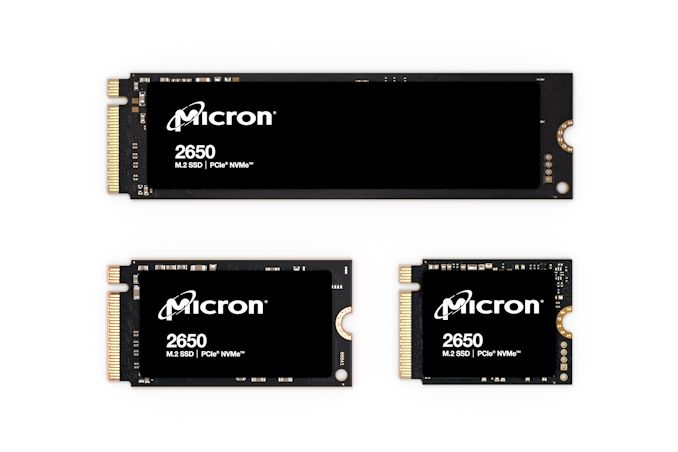Micron Ships Denser & Faster 276 Layer TLC NAND, Arriving First In Micron 2650 Client SSDs
by Anton Shilov on July 31, 2024 11:15 AM EST
Micron on Tuesday announced that the company has begun shipping its 9th Generation (G9) 276 layer TLC NAND. The next generation of NAND from the prolific memory maker, Micron's latest NAND is designed to further push the envelope on TLC NAND performance, offering significant density and performance improvements over its existing NAND technology.
Micron's G9 TLC NAND memory features 276 active layers, which is up from 232-layers in case of Micron's previous generation TLC NAND. At this point the company is being light on technical details in their official material. However in a brief interview with Blocks & Files, the company confirmed that their 276L NAND still uses a six plane architecture, which was first introduced with the 232L generation. At this point we're assuming Micron is also string-stacking two decks of NAND together, as they have been for the past couple of generations, which means we're looking at 138 layer decks.
| Micron TLC NAND Flash Memory | |||
| 276L | 232L (B58R) |
176L (B47R) |
|
| Layers | 276 | 232 | 176 |
| Decks | 2 (x138)? | 2 (x116) | 2 (x88) |
| Die Capacity | 1 Tbit | 1 Tbit | 512 Gbit |
| Die Size (mm2) | ~48.9mm2 | ~70.1mm2 | ~49.8mm2 |
| Density (Gbit/mm2) | ~21 | 14.6 | 10.3 |
| I/O Speed | 3.6 GT/s (ONFi 5.1) |
2.4 GT/s (ONFi 5.0) |
1.6 GT/s (ONFI 4.2) |
| Planes | 6 | 6 | 4 |
| CuA / PuC | Yes | Yes | Yes |
On the density front, Micron told Blocks & Files that they have improved their NAND density by 44% over their 232L generation. Which, given what we know about that generation, would put the density at around 21 Gbit/mm2. Or for a 1Tbit die of TLC NAND, that works out to a die size of roughly 48.9mm2, comparable to the die size of a 512Gbit TLC die from Micron's older 176L NAND.
Besides improving density, the other big push with Micron's newest generation of NAND was further improving its throughput. While the company's 232L NAND was built against the ONFi 5.0 specification, which topped out at transfer rates of 2400 MT/sec, their new 276L NAND can hit 3600 MT/sec, which is consistent with the ONFi 5.1 spec.
Meanwhile, the eagle-eyed will likely also pick up on Micron's ninth-generation/G9 branding, which is new to the company. Micron's has not previously used this kind of generational branding for their NAND, which up until now has simply been identified by its layer count (and before the 3D era, its feature size). Internally, this is believed to be Micron's 7th generation 3D NAND architecture. However, taking a page from the logic fab industry, Micron seems to be branding it as ninth-generation in order to keep generational parity with its competitors, who are preparing their own 8th/9th generation NAND (and thus cliam that they are the first NAND maker to ship 9th gen NAND).
And while this NAND will eventually end up in all sorts of devices – including, no doubt, high-end PCIe Gen5 drives thanks to its high transfer rates – Micron's launch vehicle for the NAND is their own Micron 2650 client SSD. The 2650 is a relatively straightforward PCIe Gen4 x4 SSD, using an unnamed, DRAMless controller alongside Micron's new NAND. The company is offering it in 3 form factors – M.2 2280, 2242, and 2230 – with a modest set of capacities ranging from 256GB to 1TB.
Micron's 2650 NVMe SSDs offer sequential read performance of up to 7000 MB/s as well as sequential write performance of up to 6000 MB/s. As for random performance, we are talking about up to a million read and write IOPS, depending on the configuration.
| Micron 2650 SSD Specifications | |||
| Capacity | 1 TB | 512 GB | 256 GB |
| Controller | PCIe Gen4 DRAMless | ||
| NAND Flash | Micron G9 (276L) TLC NAND | ||
| Form-Factor, Interface | Single-Sided M.2-2280/2242/2230 PCIe 4.0 x4, NVMe 1.4c |
||
| Sequential Read | 7000 MB/s | 7000 MB/s | 5000 MB/s |
| Sequential Write | 6000 MB/s | 4800 MB/s | 2500 MB/s |
| Random Read IOPS | 1000K | 740K | 370K |
| Random Write IOPS | 1000K | 1000K | 500K |
| SLC Caching | Yes | ||
| TCG Opal Encryption | 2.02 | ||
| Write Endurance | 600 TBW | 300 TBW | 200 TBW |
The performance of the drives scales pretty significantly with capacity, underscoring how much parallelism is needed to keep up with the PCIe Gen4 controller. The rated capacity of the drives scales similarly, with the smallest drive rated for 200TBW (800 drive writes), while the largest drive is rated for 600 TBW (600 drive writes).
“The shipment of Micron G9 NAND is a testament to Micron’s prowess in process technology and design innovations,” said Scott DeBoer, executive vice president of Technology and Products at Micron. “Micron G9 NAND is up to 73% denser than competitive technologies in the market today, allowing for more compact and efficient storage solutions that benefit both consumers and businesses.”
Micron's G9 276-layer TLC NAND memory is also in qualification with customers in component form, so expect the company's partners to adopt it for their high-end SSDs in the coming quarters. In addition, Micron plans Crucial-branded SSDs based on its G9 NAND memory..
Source: Micron











4 Comments
View All Comments
emn13 - Wednesday, July 31, 2024 - link
It'd be lovely to have some competitor's processes to compare this to, especially from the market leader samsung, but also perhaps SK, WD and Kioxia?Terry_Craig - Wednesday, July 31, 2024 - link
In which process is this controller produced?Ryan Smith - Thursday, August 1, 2024 - link
No idea, as Micron doesn't disclose those details. But it's a DRAMless controller, so it's unlikely to be anything recent.deil - Thursday, August 1, 2024 - link
yup, definetly looks like one of last gen's, my guess would be either 7nm, because how good that node is, up to 14nm, but I doubt its anything other than 7nm. Higher nodes would take way more effort to tame 7GBPS speeds.